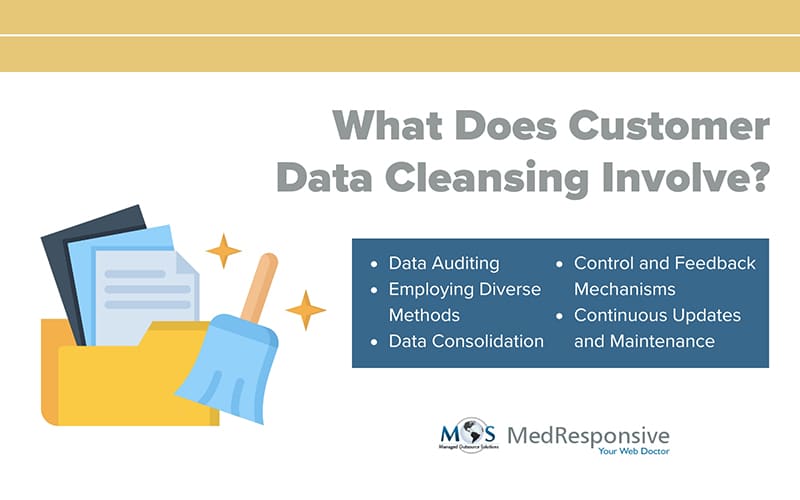Data cleansing, also known as data scrubbing, involves identifying and correcting inaccurate, incomplete and irrelevant data in a dataset. When it comes to customer information, it’s critical for organizations to maintain an updated database. Incorrect customer data can have a negative impact on a business – causing issues ranging from poor customer experiences to millions of dollars in fines for non-compliance with federal financial protection laws. With the risks involved, more and more organizations are turning to data cleansing services to maintain an accurate and up-to-date database of customer information. This post discusses the consequences of incorrect customer data, the problems it causes and how data cleansing fixes the concern.
Consequences of Incorrect Customer Data
Incorrect customer data can result in several challenges for businesses, including:
- Poor customer experiences: Businesses may misidentify customers and deliver irrelevant or wrong experiences.
- Ineffective customer insights: Incorrect data can reduce the effectiveness of customer insights and lead to decisions that don’t support business objectives.
- Decreased productivity: Employees may need to spend additional time cleaning and correcting data, which can lead to decreased productivity.
- Increased costs: Poor data quality can lead to increased costs.
- Longer lead times: Poor data quality can lead to longer lead times to complete tasks.
Despite the importance of maintaining correct customer info, reports indicate that customer data inaccuracy is a widespread problem impacting many industries.
A Model N survey highlighted revenue losses in the pharmaceutical industry due to poor customer data management, according to a 2024 BioSpace report. Data accuracy was cited as the top challenge, with 95% of respondents identifying poor membership data management as a revenue-impacting issue. Inaccurate data leads to poor pricing, incorrect rebates, revenue loss, and potential government penalties.
In September 2024, TD Bank was fined nearly $28 million by the Consumer Financial Protection Bureau (CFPB) for sharing inaccurate customer information, potentially jeopardizing access to credit, housing, and employment for affected individuals.
Maintaining a clean customer database can be quite challenging. Customer information is highly dynamic and can become outdated rapidly. Furthermore, many businesses maintain multiple databases based on various criteria, like purchase history, email lists, and prospect lists. This often results in the same customer appearing in several databases, with different pieces of relevant information associated with each criterion.
Data cleansing is essential to maintain a clean customer database and create a single customer view – a single record for each customer that contains all their relevant data.
What Does Customer Data Cleansing Involve?
Effective customer data cleansing is a multi-step process designed to ensure data accuracy, consistency, and reliability.
Here are the key components involved:
- Data Auditing
The first step in data cleansing involves a thorough audit of all customer databases. Using statistical or database methods, anomalies and inaccuracies are detected. The analysis helps infer the nature and location of these issues, enabling identification of their root causes for better remediation.
- Employing Diverse Methods
Data auditing shouldn’t rely solely on internal statistical or database analyses. External data sources can be purchased and compared against internal data to improve accuracy. For organizations with limited time or resources, outsourcing data cleansing to professional firms can be an efficient alternative.
- Data Consolidation
Data cleansing goes beyond merely removing inaccuracies; it’s an opportunity to enrich and consolidate customer data. Additional details like email addresses, phone numbers, and alternative contacts should be added whenever possible to create a more comprehensive and reliable database.
- Control and Feedback Mechanisms
Establishing robust control mechanisms ensures ongoing accuracy. For example, undelivered emails due to incorrect addresses should trigger a reporting process to cleanse invalid information from the database. A feedback loop helps maintain data quality in real time.
- Continuous Updates and Maintenance
Data cleansing is not a one-time activity but an ongoing process. Regular removal of outdated or inaccurate information, along with consistent updates, is essential to maintain a clean and actionable customer database as part of the organization’s routine workflow.
By following these steps, your business can maintain a high-quality customer database that drives better decision-making, enhances customer relationships, and reduces operational inefficiencies.
Organizations facing constraints in time, resources, personnel, or budget can benefit from partnering with data cleansing companies to get the task done. These companies leverage skilled data analysts and advanced tools to deliver accurate and relevant business records. By outsourcing, businesses can achieve better information sharing across departments, improved response rates through correct contact details, enhance compliance, and adherence to standard industry database file formats, ensuring informed decision making and revenue growth.
Maintain precise, reliable, and actionable customer data with our data cleansing services!





